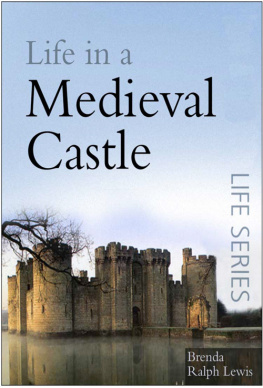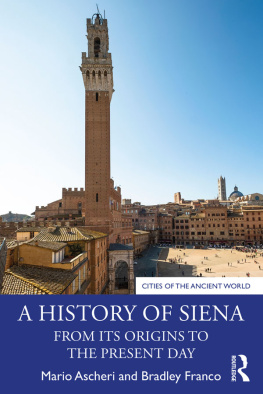Garrisoning the Borderlands of Medieval Siena
Through a close study of local demographies and topographies, this study considers patterns of piety, charity and patronage, and by extension, the development of art and architecture in Sienas southern contado during the thirteenth and fourteenth centuries.
Garrisoning the Borderlands of Medieval Siena describes SantAngelo in Colle as a designated castello di frontiera under the Sienese Government of the Nine (12871355), against the background of Sienas military and economic buoyancy during the early fourteenth century. At the same time, mining thoroughly the Tax Record of 1320 and the Boundary Registration of 1318 and presenting a large number of individual records that have not been published before including wills, tenancy agreements, land exchange and sharecropping contracts the author constructs a portrait of the people, buildings and surrounding countryside of SantAngelo in Colle. Finally, adopting the methodological approach of first considering patterns of ownership of land and property in the context of identifying potential patrons of art, the study considers patterns of piety and charity established in the early fourteenth-century village and the extent to which these affected the development of the urban fabric and the embellishment of key buildings in medieval SantAngelo in Colle.
After a career in University teaching in the UK, most recently in the department of Art History at Birkbeck College, University of London, Anabel Thomas has for the last ten years lived in Tuscany. She is the author of The Painters Practice in Renaissance Tuscany (Cambridge University Press, 1995) and Art and Piety in the Female Religious Communities of Renaissance Italy (Cambridge University Press, 2003) as well as of articles in learned periodicals in the UK, USA, and Italy.

Stato di Siena, parte dello Stato Fiorentino, 1599. Biblioteca Comunale degli Intronati, Siena.
First published 2011 by Ashgate Publishing
Published 2016 by Routledge
2 Park Square, Milton Park, Abingdon, Oxon OX14 4RN
711 Third Avenue, New York, NY 10017, USA
Routledge is an imprint of the Taylor & Francis Group, an informa business
Copyright 2011 Anabel Thomas
Anabel Thomas has asserted her right under the Copyright, Designs and Patents Act, 1988, to be identified as the author of this work.
All rights reserved. No part of this book may be reprinted or reproduced or utilised in any form or by any electronic, mechanical, or other means, now known or hereafter invented, including photocopying and recording, or in any information storage or retrieval system, without permission in writing from the publishers.
Notice:
Product or corporate names may be trademarks or registered trademarks, and are used only for identification and explanation without intent to infringe.
British Library Cataloguing in Publication Data
Thomas, Anabel.
Garrisoning the Borderlands of Medieval Siena : SantAngelo
in Colle : Frontier Castle under the Government of the Nine
(1287-1355).
1. Siena (Italy)--History--Rule of the Nine, 1287-1355.
2. SantAngelo in Colle (Italy)--History. 3. SantAngelo
in Colle (Italy)--Social conditions. 4. SantAngelo in
Colle (Italy)--Population--History--To 1500.
5. SantAngelo in Colle (Italy)--Buildings, structures,
etc.--History--To 1500. 6. Geography, Medieval--Italy--
SantAngelo in Colle.
I. Title
945.5804-dc22
Library of Congress Cataloging-in-Publication Data
Thomas, Anabel.
Garrisoning the Borderlands of Medieval Siena : SantAngelo in Colle, Frontier Castle
under the Government of the Nine, 1287-1355 / Anabel Thomas.
p. cm.
Includes bibliographical references and index.
ISBN 978-1-4094-2603-5 (hardcover : alk. paper) 1. Siena (Italy)--History--Rule of the
Nine, 1287-1355. 2. Castles--Italy--Siena--History. 3. City walls--Italy--Siena--History.
4. Gates--Italy--Siena--History. 5. Architecture, Medieval--Italy--Siena--History.
6. Social history--Medieval, 500-1500. I. Title.
DG975.S5T47 2011
945.58104--dc22
2011005540
ISBN 9781409426035 (hbk)
Front cover
Frontispiece
(black and white/landscape) Stato di Siena, parte dello Stato Fiorentino, 1599 Biblioteca Comunale degli Intronati, Siena, Ex Museo Civico III.0001 Su autorizzazione della Biblioteca Comunale degli Intronati di Siena
Colour plates
1 (landscape) Aerial view of SantAngelo in Colle.
Photograph by Andrea Rabissi
2 (landscape) View of SantAngelo in Colle from the north.
Photograph by Andrea Rabissi
3 (landscape) Palazzaccio, SantAngelo in Colle.
Photograph by Andrea Rabissi
4 (portrait) 1820 Catasto map of SantAngelo in Colle and its environs.
Archivio di Stato, Siena, Catasto, Mappa di Montalcino, Sezione M bis, di Sant:Angelo in Colle, no. 32a. Courtesy of Archivio di Stato di Siena
Black and white illustrations
The farmer cleaves the earth with his curved plough. This is his yearlong work, thus he sustains
His homeland, thus his little grandchildren,
His herds and trusty bullocks. Never a pause!
The seasons teem with fruits, the young of flocks,
or sheaves of Ceres corn; they load the furrows
And burst the barns with produce. Then, come winter,
The olive-press is busy; sleek with acorns
The pigs come home; the arbutes in the woods
Give berries; autumn sheds its varied windfalls;
And high on sunny terraces of rock
The mellow vintage ripens.
Virgil, The Georgics , Book Two, Penguin Classics, translated into English verse with introduction and notes by L.P. Wilkinson, Penguin Group, 1982, Courtesy Penguin Group (UK)
This is the story of SantAngelo in Colle, a medieval Tuscan frontier castle guarding Sienas southern borders, under the Government of the Nine. The period of the Government of the Nine a group of nine governing priors, who managed the affairs of Siena between 1287 and 1355 was when SantAngelo in Colle achieved its greatest military and political significance. It was also the period during which most of the local inhabitants, as in Virgils Georgics , were daily involved in the working of the land, the rearing of livestock and the production of oil, cheese and wine.
SantAngelo in Colle sits like a crown upon the top of its own individual hill, eight kilometres south of Montalcino, and overlooking the broad plains of the orcia and ombrone Rivers (see by the end of the thirteenth century establishes it as one of the early Tuscan communes.
Eight centuries later, what was once a buzzing hive of activity seems unnaturally quiet. Within the original perimeters of SantAngelo in Colle there is now a sense of shutters closing. More and more buildings fall empty. The memories are increasingly those of loss. The last resident priest, Don Antonio Brandi, retired in 2006 and to the great sadness of his many friends, colleagues and parishioners died shortly thereafter. The bells continue to punctuate the daily round, but more often than not, they seem to mark another departure. With each passing, the accompanying funeral cortege that winds its way down from the main square and parish church of San Michele Arcangelo appears more aged, but not less purposeful in the common desire to render an appropriate farewell.











